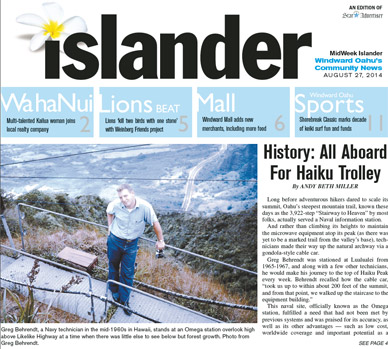History: All Aboard For Haiku Trolley
Long before adventurous hikers dared to scale its summit, Oahu’s steepest mountain trail, known these days as the 3,922-step “Stairway to Heaven” by most folks, actually served a Naval information station.
And rather than climbing its heights to maintain the microwave equipment atop its peak (as there was yet to be a marked trail from the valley’s base), technicians made their way up the natural archway via a gondola-style cable car.
ww-082714-haiku-peak-1
Greg Behrendt was stationed at Lualualei from 1965-1967, and along with a few other technicians, he would make his journey to the top of Haiku Peak every week. Behrendt recalled how the cable car, “took us up to within about 200 feet of the summit, and from that point, we walked up the staircase to the equipment building.”
This naval site, officially known as the Omega station, fulfilled a need that had not been met by previous systems and was praised for its accuracy, as well as its other advantages — such as low cost, worldwide coverage and important potential as a GPS integrity check.
“It was a most wonderful experience every time I was at the top … many times up above the clouds, so Likelike Highway and the Wilson Tunnel could not be seen as we looked down below,” said Behrendt of his weekly ascents.
Referring to the physical landscape’s fickle personality, he added fondly, “There also were times the wind was blowing fiercely up one side of the mountain, and on the other side the weather was calm as could be.”
For 55 years, from 1942 to its official closure in 1997, Haiku Valley and its mountaintop beacon reigned as a world leader in radio technology — and it was believed to have saved countless lives because of its vital message transmissions and deliverance of intelligence data.
Initial construction was among the most difficult jobs undertaken during the war, it’s said, forcing the introduction of new engineering techniques and creative, cutting-edge radio technology. As a result of the radio tower’s presence, the verdant Haiku valley remains a relatively unspoiled sanctuary to this day.
“I don’t know how many people have had the opportunity to make the climb,” speculated Behrendt, now retired and living in Wisconsin, “but I am confident that each of them who have made it to the top experienced a glorious view.”







